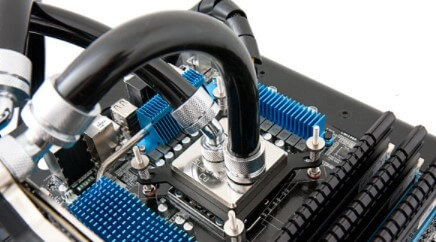
Welcome to the latest in our highly popular series of beginners guides, this time we will be taking a look at the often misunderstood world of water cooling.
I should point out that this is not a buying guide as such, it is simply an article to get you up and running, and keep you up and running with minimal fuss.
There are many water cooling guides dotted around the tinterweb, but I want to try and simplify things even further and address as many of the frequently asked questions as possible.
If you take your time, and follow the basic steps in this guide, you will find that building your first water cooling loop can be a very rewarding and trouble free exercise.
Why water cooling?
Well, there are three main reasons that you may want to go with water cooling:
- High performance cooling - Generally much better temps than with air cooling, which usually equates to better overclocking potential too.
- Silence - Most people don't want a hair dryer on their desk, water cooling can transform your noisy air cooled computer into a much more palatable, near-silent machine.
- The bling factor/Aesthetics - Done correctly, a water cooled rig can be a real talking point, you needn't spend a fortune to get a great looking rig (although you can do!), some people like the understated look, others like the whole UV look, more on this later.
Of course, you may want to combine all three aspects and go for a super high end system, we'll get to the pros and cons of that later.
What We Are Not Going To Do In This Guide
As in most areas of computing, there are purists, water cooling is no exception, and many people love nothing more than to spend hours and lots of money trying to shave off that extra 0.5C here and 0.5C there in their quest for perfection. We've all been there, buying the most expensive water block, a couple of pumps, special fluid that promises lower temps.....bah! Will these extra fractions of a degree here and there do anything for your overclocks, well, no, not really. There are small benefits to be had, but once you get yourself a moderately good water cooled set up, you enter the land of diminishing returns and the more you spend, the less extra performance you get for your money with each step up.
What We Are Going To Do In This Guide
In this guide, we will take you step by step through a basic CPU/GPU water cooling loop set up from start to finish. There are many different methods that people use for the various different aspects of water cooling, however, this guide will feature my own preferred methods and while some people may prefer other ways of doing things, everything mentioned here has worked well for me over the years and will no doubt work well for you. Try it and see! To sum up, we are going to look at building you a great water cooled system, if you want to tweak it to within an inch of its life later on, that's up to you!
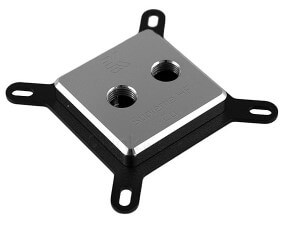
Selecting And Buying The Parts
As I've already mentioned, this isn't a buying guide as such, just a few pointers to help you establish what kind of gear you need for your system.
Ask yourself, do you want performance or silence, or both? Do you just want the bling factor?
Generally, if you want both performance and silence, you will end up paying a premium for high end parts. If you don't have a set budget, this is fine, but if you do, a little research is required and this is where you should ask on the forums for help.
Cheap And Nasty Water Cooling.
There are few things to be aware of when purchasing your gear, firstly, avoid the cheap Chinese kits, they are usually garbage. You may also find some similarly manufactured separates, blocks, pumps etc, these too can be avoided, they really aren't worth the hassle. Buy brands you know from reputable sellers (see our list of specialist water cooling sellers).
Entry Level All-In-One Water Cooling Kits.
These kinds of kits have been around for a number of years, Asetek have been at the forefront with these all in one kits, however the performance is generally slightly less than moderate to good air cooling. Corsair's H50 has improved on the Asetek design, but the performance still falls well short of the kind of water cooling that we are going to be looking at in this guide. Some designs fail completely.
CPU Water Blocks.
There are dozens of CPU blocks on the market to choose from, ranging from relatively cheap (sub £20), to right up to £80. The difference in performance between these blocks for most people isn't necessarily worth the money, with maybe 5-8C between the mid to high range blocks. From an aesthetics point of view, some of those high end blocks do look the business and will be a nice focal point in your rig, so that's something else to consider. In recent months, the trend has been to nickel plate everything to provide a shiny silver finish, this not only looks great, it doesn't tarnish like bare copper does, but it still has excellent heat conductivity.
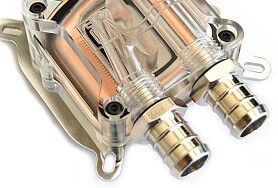
GPU Water Blocks
Standard / Universal GPU Water Blocks.
The standard (or universal) GPU blocks can often be swapped from card to card over the course of a few upgrades, so if cost is a factor, then this type of block may be worth a look. The downsides are that they don't quite have the same good looks as their full cover cousins, and also they do not cover the VRAM or VRMs, so you will have to use RAM sinks or other after market coolers to cool those.
Full Cover GPU water blocks
Full cover GPU blocks look great and can make it a bit easier to fit the tubing in certain circumstances, and they also cool the graphics card's memory (VRAM) as well. The only real drawback to these is that the heat from the VRAM will end up in the water and will need to be dissipated. It isn't a huge amount of heat, but it is worth keeping in mind.
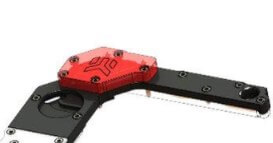
Other Water Blocks
Motherboard Water Blocks.
Whether you need one of these or not, largely depends on what motherboard you have and what you plan on doing with it. Some motherboards run very hot and can benefit from having their PWM section cooled, others run hot on the north bridge or south bridge, so again, this is something to look into before you start. For those people going for fantastic looks, these type of blocks are perfect. The only real downsides are that they are expensive, they are tailored to a specific board and usually bolt on from the rear of the motherboard, so if you need to remove the block for some reason, it will mean removing your motherboard from the case, which will sometimes mean removing the rest of the loop, depending on how it has been tubed. Bottom line - They look great and cool well, but can be a pain to work with and have a short working life.
Chipset / Northbridge / Southbridge Water Blocks.
On previous generations of motherboards, the memory controller (Northbridge) was part of the motherboard and this could get quite hot during overclocking, today's i7 platform has the memory controller on the CPU, so the only thing left on the board where the Northbridge was, is the chipset, or IOH (In/Out Hub). This generally runs quite cool for most of the time, but if you are running a pair of large graphics cards, the IOH can get start to get hot, whether it needs water cooling is entirely up to you, but my preference is to leave it air cooled on i7 systems. Also, this IOH/Chipset area is most likely covered by the "Motherboard Water Blocks" section above.
If you do need a chipset/NB/SB block, I can recommend the EK number 5 shown below, the Dangerden Intel Universal MPC block is also excellent, as is the Swiftech MCW30. They all have their plus points and draw backs, but I prefer the EK for ease of mounting and general build quality.
Use extreme care when fixing one of these to a bare die, if you rock it about, you can crack the die, or break off its corners, you can also damage the base of the block. The best way to fit one of these is to use a gasket that fits round the die and stops the block wobbling too much, although you still need to be really careful. Hold the block firmly on the die and tighten the screws until just about finger tight and see how it is, if it needs to go tighter, just a quarter turn at a time should do the trick.
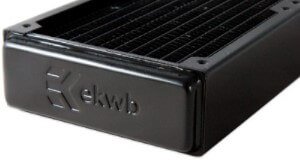
Radiators And Shrouds
Radiators can be quite bulky, so this is one of the main reasons to plan ahead. If you can imagine a radiator fixed to the top of your case (or wherever) and then add to that a set of fans, and then your barbs and enough tubing so that it can bend without kinking and you have taken up a fair old chunk of space.
There are some really good radiators on the market, but generally, you get what you pay for, possibly the best performing radiators out there are the Thermochill PA series, but, they do have their downsides in so much as they are quite bulky and much deeper than most other radiators and their paint job is truly awful and you will also need 3/8BSP barbs.
There are lots of different sizes of radiator available, from 120mm and 160mm singles, to the old favourite 360mm (3x120mm), and more and more manufacturers are going down the 140mm route, so we have a few products emerging that use three and even four 140mm fans.
How do I know what size radiator I'll need?
This can be a tricky one, and it really depends on what exactly you plan to cool and what your aim is as far as silence and performance are concerned.
An example would be, I have run a Thermochill PA120.2 for around two years in our test rig, this only had to cool our CPU, which at times was a heavily overclocked i7 920. This set up never missed a beat and ran with near silent fans, however, if you were to add a GPU into that same loop, then things would change slightly, the extra heat generated would have to be dissipated somehow or the water temp would gradually creep up and up, so by adding slightly more powerful fans, we can dissipate the heat more quickly. Unfortunately, faster fans generate more noise, so this solution isn't ideal for everyone, so the only real alternatives are to either dump the 120.2 and add a 120.3 or bigger, assuming we have the space, or we could add in a second radiator into the loop, even a single, decent 120mm will take the pressure off the 120.2 and allow you to run quieter again, an extra 120.2 would take the pressure off and leave you some headroom for future upgrades. Make sense so far? Good!
Fan Hole Spacing
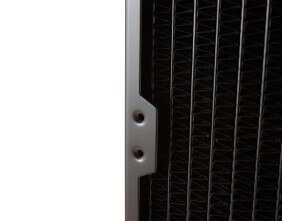
This issue is becoming more and more irrelevant, but it's worth a mention for those people buying used gear. Older Thermochill radiators used a 25mm spacing between the fan screw holes that separate each fan on the radiator, nowadays they use 15mm, the same as everyone else. There were many accessories (and still are) and a few cases cut to fit the old 25mm spacing, so this is something to consider when making your purchase. Ideally, 15mm will give you a bit more longevity.
Another issue that buyers should be aware of on older Thermochill radiators is that they use self tapping screws to attach the fans to them, I've never really understood why, but they were designed in such a way that if you didn't use the neoprene gasket that came with the radiator, or indeed a fan grill, the supplied screws would puncture the core of the radiator when you fitted it in place. I have killed an old PA120.3 myself this way, so I think it's best that people are aware of it, although I believe that they have changed over to machine screws now. I would still be wary of tightening the screws too far though. You have been warned!
Shrouds
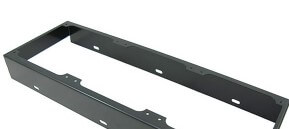
What is a shroud? A shroud is simply a device that allows the radiator fans to be slightly further away from the core of the radiator and this gives a number of benefits.
Firstly, all 120mm fans have a "dead spot", in other words, if you place a fan close to the core, there will be an area in the centre of the fan that has no air being pushed from it, and of course, the cooling to that part of the core will be less than the outer areas that are getting the full blast of air. Raising the fan off the core by a few centimetres can help improve performance slightly, but also, it can reduce noise too. You can do an experiment with this yourself, grab a piece of mesh or some material and hold it up to the blowing side of a fan, the closer you get, the louder the wind noise will become, the shroud works in the same way.